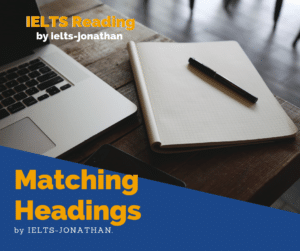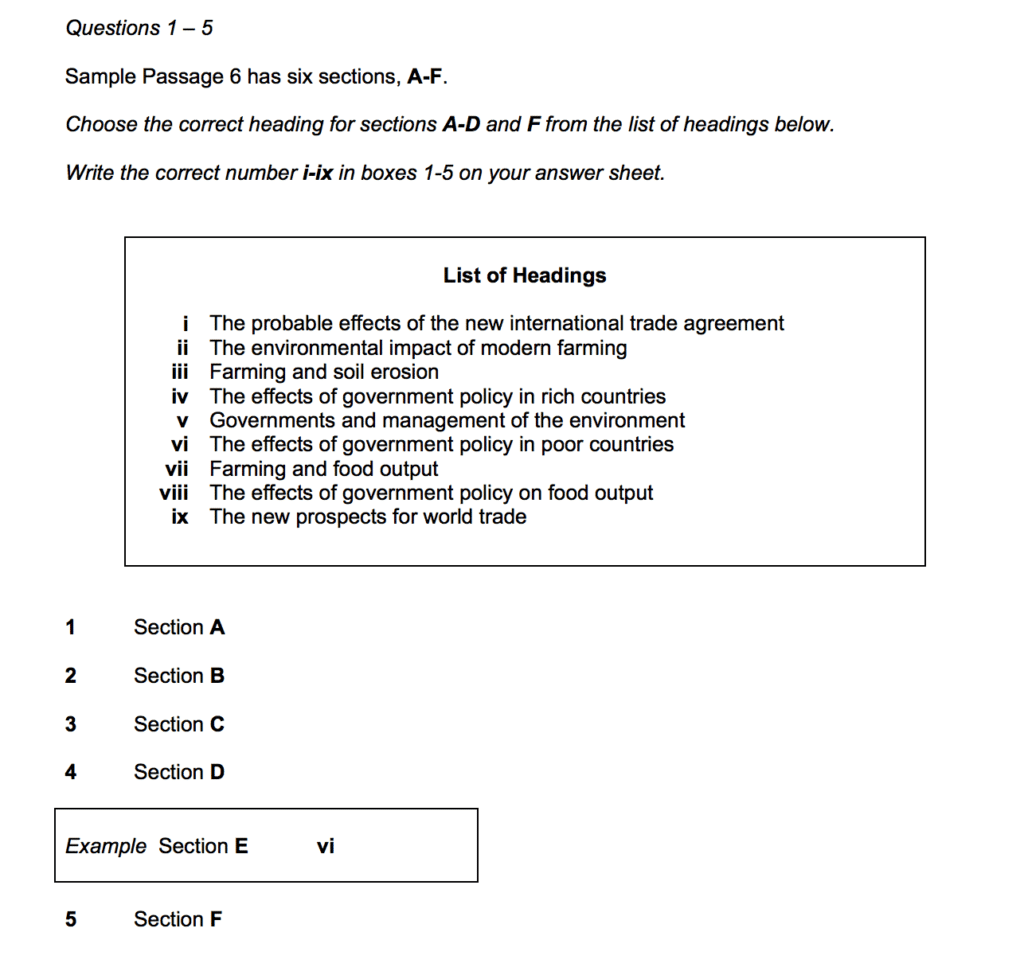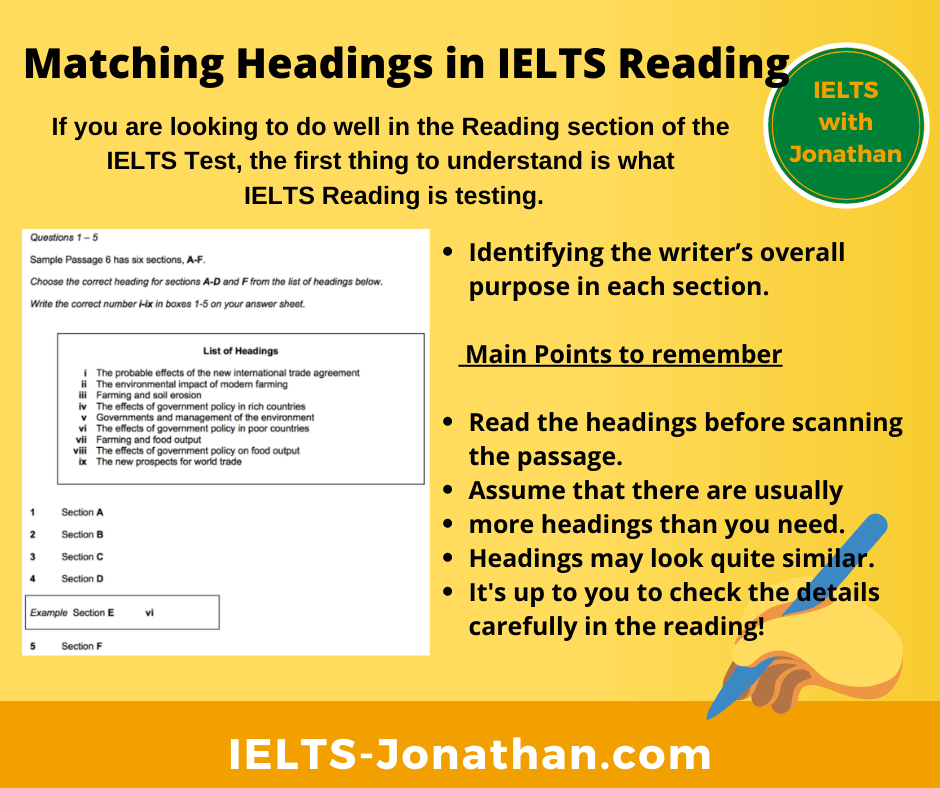How to do matching headings tasks
I always suggest being careful with this type of question.
These questions may seem like a simple matching exercise, but there is more to it than at first appears.
It’s important to understand what this kind of question is testing and some of the common problems that students have if they are not prepared.
So, let’s briefly begin to understand the task and it’s purpose.
Just to summarise, the reading section lasts for one hour and the exam format for the Reading section is 3 reading passages and 40 questions.
Each reading passage has 3 or 4 different types of question to answer so this question can come almost anywhere. 🙂
Matching Headings in IELTS Reading
This is an example of a Matching Headings question.
In the first box of this question, you can see the headings you can choose from. These are numbered in Roman numerals (i -vi).
Below that , is the area where you match your heading choice with the section A, B, C etc.
These are numbered in order.
What may look like a simple task, hides many subskills which you need to utilize for a good score in this area.
To understand this, I have summarised the question type by describing these skills and thought of some useful tips to help you deal with this section.
The Task:
As you can see, the basic task is matching the most appropriate heading (signified by numerals) to the appropriate section in the reading passage, signified by a letter.
It should be clear that how you organise your answers is important and care needs to be taken transferring the answers, as just one mistake could ruin this section.
As well as the se organisation skills, the section also tests your cognitive skills.
You have to deal with multiple information such as numerals, numbers, letters, select headings and evaluate extensive text under test conditions.
What skills are needed for matching headings?
The first practical skill is to be able to skim and scan read.
For each of the five sections of the extensive reading (A – D) gaining the overall gist of the section by skimming reading will help you identify the probably headings that match the section.
Once you have an educated idea of the likely matches, then scanning takes place for specific information that confirms the heading is correct or not.
If you need to brush up on what these skills are, there’s a skimming and scanning post with practical explanations of these important IELTS skills here.
What are sections for?
Let’s be clear now and understand what a section means, and the differences to a paragraph.
First of all, the aim of a section is very different to a paragraph.
Sections may deal with overall themes.
For example, they may have a particular purpose in the reading.
The purpose might be to introduce the discussion, present the issue, consider the problems, suggest the solutions, summarise the information discussed and conclude.
So you need to be able to skim read quickly to gain an idea of the theme of a section.
Understanding what paragraphs are for
While sections may have a number of general points, controlled by a heading, the aim of a well-written paragraph is to present one main idea.
Paragraphs do not usually have headings to indicate the content, but you can find the main idea of a paragraph in the topic sentence.
In simple writing, the topic sentence is often found at the beginning of the paragraph, but you may have to read further to identify the topic in the more complex writing found in IELTS.
This is a simple example of a topic sentence.
‘For many years, the meat industry has had a significant impact on the farming methods of developing countries. This influence on farming methods can be seen in……..etc’
You can see how the topic is introduced clearly. For many years, the meat industry has had a significant impact on the farming methods of developing countries.
Another way of identify a topic sentence is to look for contrasting linking words.
‘However, as countries become more developed it is clear that farming methods change in response to the needs of both consumers and exports.’
In the example, the contrasting statement ‘however‘ signifies that the new topic is being introduced.
If we combined these two sentences, then the topic is controlled by the contrasting linking words.
‘For many years, the meat industry has had a significant impact on the farming methods of developing countries, however, as countries become more developed it is clear that farming methods change in response to the needs of both consumers and exports.’
Generally, the topic will not be more that half way through a paragraph, so scan the first 35% of a paragraph for the topic.
How to combine the meaning of sections and paragraphs
So remember, paragraphs have one idea and although sections may have a number of general ideas, it is the headings which dictate the theme
To identify the theme you need to scan for the main ideas and supporting points.
As your scanning, it is easy to be confused by information inserted in the text or overlook some important details.
These are known as ‘distractors‘.
If you are not aware of distractors, then you are likely to jump to the wrong conclusion and make the wrong choice.
A good example of a distractor is locating a section in the reading text by skim reading for keywords or synonyms and then discovering the main topic is different.
For example, the passage may discuss the ‘effect of government policy’ on developed countries and developing countries‘, but the main focus of the section is on ‘food production‘.
Here ‘developed‘, ‘developing’ and ‘production‘ have replaced the keywords in the headings, ‘rich‘, ‘poor‘ and ‘output.’
So always skim for the general theme, check the headings, then scan to check the headings match the keyword topic details and the final that these tally with the headings.
What hints and tips can help you?
Reading the headings quickly before reading the passage always helps. This will help you recognise the key words and synonyms from the headings. once you think you have found the correct section you can scan the keywords in the text.
Be careful, just because you see a keyword does not mean that is the topic of the paragraph. You still need to read carefully around the text to confirm.
You should be clear there are usually more headings than you need and some of these headings might look similar so again, be careful for distractors
In the example question, headings i and heading vi are quite similar and viii is related too.
You will need to check the details carefully in the reading text to confirm your decisions.
There are likely to be many new words that you are not familiar with.
Don’t be distracted by these new words.
Use the context to try and understand the general meaning, but don’t focus on the meaning too much.
Most of the surrounding information will help you move on
Conclusion
While IELTS reading is primarily testing you language knowledge and abilities, it is also tests a number of subskills such as being able to deal with a complex text at university or in the workplace.
You do need to have a good basic level of vocabulary, but there will be many words and phrases you will have to work around or interpret from the context.
Importantly, as with any IELTS Reading question, always make sure you have practised and understood the main point of the task as this will help you significantly.
Feel free to share and comment with any questions, or if I’ve forgotten something.
Good Luck with you IELTS Preparation
Jonathan
I’m Jonathan
I’ve taught IELTS and University English in more than a dozen universities and schools around the world.
I’m a parent, traveller and passionate about language teaching and helping students achieve their dreams.
Whilst living in Austria or working in Asia, I run IELTS courses to help students get to where they want to be.
If you are serious about IELTS, connect with me to see how I can help you.






.